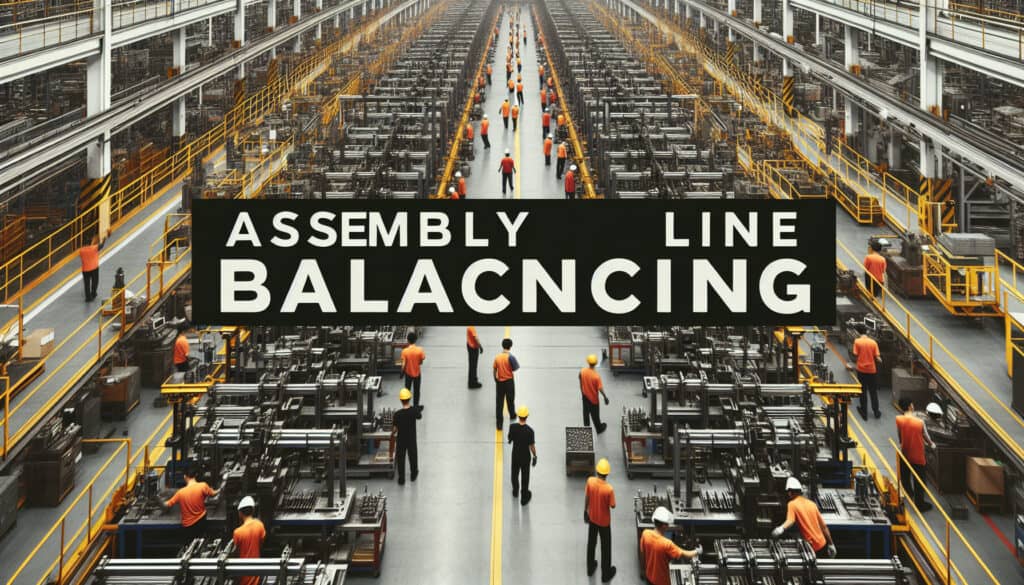The process of assigning tasks to workstations in a way that minimizes the total amount of idle time.
- Metodologías: Ergonomía
Assembly Line Balancing

Assembly Line Balancing
- Mejora continua, Diseño para la fabricación (DfM), Eficiencia, Manufactura esbelta, Optimización de procesos, Eficacia de la producción, Gestión de calidad, Mapeo del flujo de valor
Objetivo:
Cómo se utiliza:
- Assembly line balancing is a classic optimization problem in industrial engineering. It is used to design and configure assembly lines to maximize efficiency and throughput.
Ventajas
- Increases production efficiency, reduces idle time, and improves the overall performance of the assembly line.
Contras
- Can be a complex and time-consuming problem to solve, requires accurate data on task times, and may not be suitable for all types of assembly lines.
Categorías:
- Ingeniería, Lean Sigma, Fabricación
Ideal para:
- Optimizing the design and configuration of assembly lines.
Assembly line balancing finds extensive application in industries such as automotive manufacturing, electronics, appliance assembly, and consumer goods production, where the combination of efficiency and quality is paramount. In these sectors, the method is implemented during the design and configuration phases of production systems, particularly when establishing new assembly lines or reconfiguring existing ones to adapt to demand fluctuations or new product introductions. Different stakeholders are involved in this process, including industrial engineers, production managers, and operations researchers, who collaborate to analyze work tasks, determine cycle times, and allocate resources effectively. Tools such as Work Element Analysis, which breaks down tasks into smaller components, and software applications designed for optimization algorithms, support the balancing process. By applying assembly line balancing techniques, firms can achieve a more equitable distribution of work among stations, reducing bottlenecks and minimizing waste through more effective use of labor and machinery. The methodology not only enhances production rates but can also lead to improved quality control measures by allowing for more consistent workflow and better monitoring at various stages of the assembly process. Additionally, it plays a significant role in lean manufacturing initiatives aimed at reducing lead times and increasing responsiveness to market changes. Implementing these strategies requires continuous feedback and adjustment, making it imperative for teams to establish clear communication channels among all participants involved, ensuring that performance metrics and production goals align with the overall objectives of the organization.
Pasos clave de esta metodología
- Define workstations based on tasks and their dependencies.
- Calculate task times for each operation to determine workload.
- Identify the cycle time based on desired production rate.
- Analyze the workload distribution across workstations.
- Implement balancing algorithms, such as the Largest Candidate Rule or Rank Positional Weight Method.
- Evaluate the balance efficiency using the calculated efficiency metrics.
- Adjust assignments and re-evaluate to optimize the layout.
- Finalize the assembly line configuration based on simulations or pilot runs.
- Monitor performance and make iterative improvements as necessary.
Consejos profesionales
- Utilize algorithmic approaches, such as genetic algorithms or ant colony optimization, to explore non-linear solutions for balancing problems, particularly for large-scale assembly lines.
- Implement simulation tools to model different scenarios and identify bottlenecks, allowing adjustments before real-world implementation.
- Incorporate ergonomic assessments into the balancing process, ensuring that tasks are not only efficient but also conducive to worker well-being and productivity.
Leer y comparar varias metodologías, recomendamos el
> Amplio repositorio de metodologías <
junto con otras más de 400 metodologías.
Sus comentarios sobre esta metodología o información adicional son bienvenidos en la dirección sección de comentarios ↓ , así como cualquier idea o enlace relacionado con la ingeniería.
Contexto histórico
1949
1950
1950
1960
1960
1960
1960
1940
1950
1950
1958
1960
1960
1960
1960
(si se desconoce la fecha o no es relevante, por ejemplo "mecánica de fluidos", se ofrece una estimación redondeada de su notable aparición)















Publicaciones relacionadas
Simulación de Monte Carlo
Pruebas basadas en modelos
Comprobación de modelos
Investigación con métodos mixtos
A prueba de errores (Poka-Yoke)
Pruebas del perfil de la misión